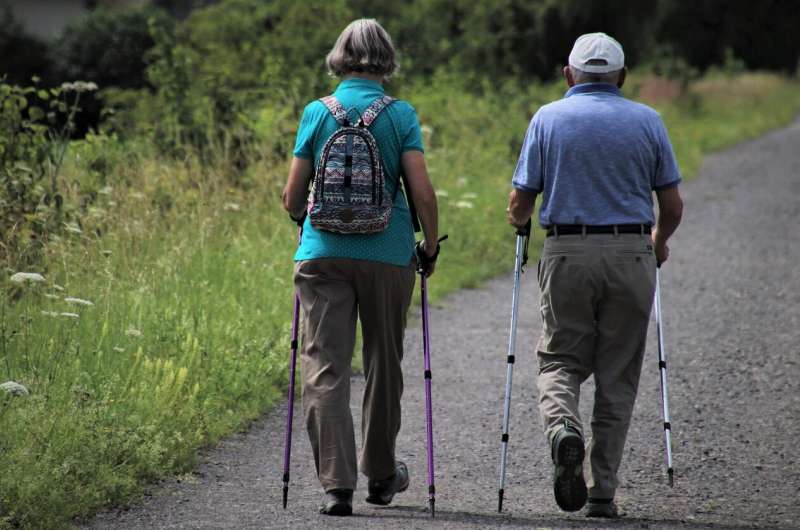This article has been reviewed according to Science X's editorial process and policies. Editors have highlighted the following attributes while ensuring the content's credibility:
fact-checked
peer-reviewed publication
trusted source
proofread
Leg pain while walking could be a sign of artery trouble in older adults

Do your legs hurt when you walk? Experts on peripheral artery disease want you to know that it isn't normal. The condition can cause serious complications, but it can be managed.
"Leg pain when you walk is not necessarily a feature of normal aging," said Dr. Natalie Evans, a vascular medicine physician at University Hospitals Harrington Heart and Vascular Institute in Cleveland. "And if you're having pain in the muscles of the legs when you walk and nobody's listening to you, you need to find somebody else to listen to you."
Peripheral artery disease, or PAD, develops when atherosclerosis—fatty plaque buildup—forms inside artery walls, narrowing the blood vessels that deliver oxygen-rich blood to a person's extremities, typically the legs and feet. More than 200 million adults worldwide have PAD, including 8 million to 10 million U.S. adults, according to a 2021 American Heart Association policy statement.
PAD is similar to coronary artery disease, in which plaque accumulates inside the arteries within the heart and can lead to a blockage in blood flow. This blockage can result in a heart attack. Plaque buildup in arteries leading to the brain can cause a stroke.
Often, people assume they are just "slowing down" as they age, or they may attribute their leg pain to something else.
"Sometimes it may feel like radiating back pain, or it's confused with an orthopedic issue," said Kim Smolderen, a clinical psychologist and outcomes researcher who co-founded the Vascular Medicine Outcomes program at Yale School of Medicine in New Haven, Connecticut. "And then they might see several different doctors before they realize where the pain is coming from, and it's not only unawareness on the patient side, but also on the provider side."
In a 2006 survey of about 2,500 U.S. adults ages 50 and older published in the journal Circulation, about 25% reported being familiar with PAD—compared with 67% for coronary artery disease and about 74% for stroke.
What PAD is not: blood clots in the legs. But blood clots can form in someone with PAD if plaque buildup causes an artery wall to rupture.
PAD also shouldn't be confused with deep vein thrombosis. DVT happens in the veins, not arteries. Long periods of immobility after surgery, an injury or during travel can lead to DVT. A piece of the clot can break off and get lodged in the lungs, a sometimes-fatal condition called pulmonary embolism.
Blood clots—not PAD—caused Deion Sanders, the college and pro football Hall of Famer, to have multiple surgeries on his legs, including two in July. Two of his toes were amputated in 2021. Sanders, now the head football coach at the University of Colorado, has said his family has a history of blood clots.
PAD may not be as acute as blood clots, but left untreated or undiagnosed, it can lead to non-healing wounds, gangrene or, in a severe case, amputation.
"I think everybody can agree that one amputation is too many," Evans said. "And unfortunately, for many patients, the first therapy they're ever offered for PAD is amputation. So, clearly, we need to do a better job recognizing this disease."
Even when PAD is not advanced, it can severely affect people's daily functioning, their well-being and their mental health, Smolderen said. For example, people are likely to walk less if it hurts to walk, she said. "People also experience high levels of chronic stress," she said. "And the overall impact on quality of life and how it defines people's identity is a big factor as well."
Risk factors for PAD are similar to those for heart disease, including older age, physical inactivity, high blood pressure and high cholesterol. People who smoke have twice the risk of PAD compared to those who don't, and the same is true for people with diabetes.
"What we need is primordial prevention of all cardiovascular disease, where we prevent people from developing risk factors," such as tobacco use and diabetes, Evans said.
Some patients may need stents inserted to open blood vessels or surgery to bypass blocked arteries. In the most severe cases, amputation may be the only treatment. But the first line of treatment for many people, Evans said, is simple and non-invasive: supervised exercise therapy.
"I tell patients it's kind of like cardiac rehab for the legs," she said. Initial treatment is usually 30 minutes of total walking time, three days a week for 12 weeks. "People can actually double their pain-free walking distance, which is an incredible improvement."
It isn't clear why supervised exercise therapy is so effective, Evans said. "Whether it's because we condition the muscles to operate in an oxygen-depleted environment, or because we actually grow new blood vessels, it's not really clear," she said. "What we know is that it works."




















